Web-only Feature
Web-only Feature

Healing from Anxiety, Depression, Trauma Using Forgiveness, Self-Compassion, and Energy Psychology while Tracking Change Over Time
Part 1: Case Study
Internet Editor’s Note: Dr. Friedman recently published an article in the Bulletin on “Excerpt from: Reflections on 50 years of integrative psychotherapy emphasizing practiced-based evidence and effectiveness.” You can find a free copy of the article: here. Additionally, Dr. Friedman published a web-only feature related to his Psychotherapy Bulletin article that can be found here.
Author’s Note: I want to thank John Freedom for his excellent comments and feedback on an earlier version of this article.
Case Study of Carolyn’s Anxiety, Depression, and Trauma
(Some information has been changed for confidentiality purposes in the case study below)
“The Universe is telling me something needs to change”
Carolyn is a 26-year-old married female with no children. She is married two years working as an interior decorator for a small company while her husband works in IT. She says she has been having a “panic attack” recently, which is the second time since college: she loses feelings in her arms and hyperventilates; her heart races; she feels like she is passing out. She expresses the feeling of wanting to run. Carolyn reports she is on medication for stomach problems and a damaged esophagus. She is also fatigued, moderately to very depressed, and quite pessimistic. She says she was very anxious in high school and drank a lot in college but was quite active socially during her college years.
Carolyn reports that a turning point happened when her 48-year-old mother, Jill, had a surprise heart attack recently. Her mother, Carolyn says, drinks and smokes too much, even after her heart attack. Moreover, she reports Jill is intimidating, fierce, very independent, and has an addictive personality. Her parents were married less than three years when they got divorced. Her 52-year-old father, David, has been generally unavailable to her. Nevertheless, she reached out to him after her mother’s heart attack. She describes him as an “oddball” who was never really present in her or her 28-year-old brother’s life. In fact, David’s social skills are “bizarre” she reports, and he is very clingy, selfish, self-absorbed, and dramatic. Still she wants to have some kind of a relationship with him, though feeling angry, hurt, neglected, abandoned, and bitter. Although she is closer with her mother, she currently speaks to her once a week. Both her parents have a history of alcohol related problems, but Carolyn says she was never physically or sexually abused.
Carolyn’s relationship with her husband, Ted, is good at times and shaky at other times. She says she can be selfish and too dependent on him. She gets impatient easily and then pulls away and withdraws. Work is stressful because there are a lot of demands placed on her as she has a responsible interior decorator position. Most of the time Carolyn is good at what she does. The company is in a transition period and she will be getting a new boss soon which she says causes her to feel upset. She says her husband does not understand what she does at her work and has his own work issues.
In addition, a close friend from college overdosed recently and a high school friend died from drunk driving. Obviously, Carolyn has been experiencing a lot of loss and trauma in her life. She wonders whether she has a post-traumatic stress disorder.
Carolyn engaged in psychotherapy twice in high school and college. She was not reporting any suicidal thoughts and was not on any psychiatric medication.
Carolyn states emphatically that the “universe is telling her something needs to change” and soon.
Here is Carolyn’s description in her own words of why she entered therapy.
“Because I was having trouble collecting my thoughts at home. It was causing stress in both my work and home environment. I came in with a lot of fear and uncontrollable thoughts. I thought I was losing self-control and was in a constant state of disequilibrium. I was having trouble with reoccurring panic attacks and I became antisocial in fear I would have another one. I couldn’t do my daily routine. I was having thought after thought and was experiencing depersonalization. I could not get my own thoughts under control. I wanted to get help because I knew that this was not the norm.”
To help further assess Carolyn strengths and weaknesses, she was administered a battery of psychological questionnaires in the waiting room before the first therapy session started. Many of these were also used to track her change over time.
The Purpose of this Article
- To use Carolyn’s story and case history to discover some key dimensions needing change (forgiveness, self-compassion, gratitude, affect, beliefs, relationships, etc.)
- To use Carolyn’s story and case history to demonstrate how to track change over time in psychotherapy on a number of measures (stress, well-being, affect, beliefs, flourishing, life satisfaction, life balance, forgiveness, self-compassion, gratitude, and spiritual awakening)
- To discover what actually changes in psychotherapy on a number of levels (psychological, neurological, external relationships, relationship with the therapist, etc.)
- To introduce some powerful healing interventions that may not be readily used by many clinicians, especially forgiveness and energy therapy (see Part 2)
- To describe how spiritual awakening can also occur during psychotherapy and how to measure and track it.
At the end of the first session I taught Carolyn the Psychological Uplifter (see Part 2 for detailed therapeutic interventions and the Psychological Uplifter Technique)
After reviewing Carolyn’s scores on the psychological assessment scales in the second session, Carolyn and I co-created the following 17 written goals.
Goal Setting
Written Goals
- Work-out physically, preferably outdoors.
- Eat healthier and regularly.
- Prevent anxiety and increase control over it.
- Decrease depression, hurt, anger, fatigue, etc.
- Be calmer and steadier, especially with things out of my control.
- Increase self-compassion, self-forgiveness, self-worth.
- Increase gratitude and forgiveness of others, especially toward my parents.
- Increase happiness, well-being, flourishing, life satisfaction.
- Increase positive beliefs and decrease negative beliefs.
- Increase hope and optimism.
- Strengthen my relationship with my husband.
- Strengthen my relationship with my Mom.
- Strengthen my relationship with my Dad.
- Be more appropriately assertive- to express my feelings more effectively.
- Increase my self-discipline.
- Go to church regularly on Sunday.
- Increase my ability to organize my finances and money.
Miracle Goal Exercise
I gave her a copy of the 17 goals and I kept a copy. She was then asked to close her eyes and imagine a miracle had happened one year from now. She was told to visualize the attainment, achievement, or experience of all of these goals (Miracle Goal exercise). Carolyn was then asked to take one small positive step in the direction of any of these goals every day. She was encouraged to do both of these exercises every day for 1-2 minutes.
Carolyn had been taught earlier the “Anything is Possible Exercise” at the beginning of therapy session two (see Part 2 for detailed therapeutic interventions).
The Forgiveness Solution Book
In session three, Carolyn was taught the “Releasing/Choosing” exercise (see Part 2 for detailed therapeutic interventions). We went over the 2 Paths Model of Happiness/Change described in my book the Forgiveness Solution (Friedman, 2010) and briefly in Part 2. This exercise emphasizes the important role of unforgiveness, judgments, and attack thoughts in causing problems and promotes forgiveness as the solution. Carolyn was given a copy of the Forgiveness Solution book. She was asked to read the Introduction and Chapter 1 in the Forgiveness Solution book and to do the exercises in Chapter 1 (Bibliotherapy is an important part of my work). Carolyn was asked to subsequently read and complete one to three chapters per week in the Forgiveness Solution book and to type up her answers to the exercises and bring them in with her.
The Forgiveness Solution book contains an extensive series of 50 plus processes and exercises throughout the book. Some are easy to do, and some are more challenging. This article will describe a few of the exercises from the book and ones we did together in the therapy session. (Needless to say, we talked every session about the stressors/challenges in her life as well as doing or reporting on the results of the exercises.)
Tracking Change
Before sharing three sets of key exercises (see Part 2) I am going to present some graphs of change over time. Prior to every therapy session, in the waiting room, Carolyn filled out some questionnaires about her experiences during the previous week and her perceptions of the therapy process, the therapist, and benefits so far in therapy.
Table 1 demonstrates the changes in Carolyn’s total Hopkins Stress Symptom Score (Derogatis et al., 1973) over 15 sessions. An average score for someone in the general population is 22. An average score for a client at intake is between 90 and 110. Carolyn’s score was 210. An intake stress symptom score of 210 is extremely high. In addition to anxiety and depression symptoms described before Table 2, Carolyn says she has difficulty making decisions, trouble concentrating, has feelings that are easily hurt, feels inferior to others, is nervous when left alone, avoids frightening things, worried that people will take advantage of her, and there is something wrong with her mind. As you can see her stress symptom score at session 5 was 22 and close to 0 by session 7.
Table 2 demonstrates, using two of the Hopkins Stress Symptom Subscales, Carolyn’s anxiety score at intake was in the very high range (39) and her depression score at intake was in the moderately high range (35). She reports she cried often, felt lonely, hopeless and blue, blamed herself and felt trapped. In addition, she says she felt very nervous, scared, restless, fearful, tense, terror, and panicky. She reports she often trembled and felt her heart pounding frequently. However, by the 5th therapy session the depression and anxiety scores had dropped to 4 and were in the average range.
Table 3 demonstrates Carolyn’s trauma symptom checklist score (Weathers et al., 2013) of 19 was moderately elevated at intake and dropped markedly over time. For example, she reports moderately high disturbance of memories and dreams; high levels of upset when things reminded her of stressful past experiences and strong physical reactions to them. She says she tried hard to avoid reminders of these stressful experiences and memories. By session 9 the next time the questionnaire was given Carolyn’s trauma score was close to the average range (8) and by the 15th session it was down to 1.
Table 4 shows that Carolyn had very low levels of well-being and happiness at intake (26-35). The Outcome rating scale or ORS (Miller et al., 2003) is a widely used brief 4 item measure of well-being-distress. It was multiplied by 2.5 to be on the same scale range as the other measures. The Friedman Well-Being Scale is a 20-item bi-polar measure of well-being-distress with 5 subscales (Friedman, 1992) and the Friedman Happiness Scale is one item drawn from the Friedman Well-Being Scale. By the 5th and 6th therapy session Carolyn’s scores were in the average range (around 64 of 100) on all 3 measures. However, Carolyn’s scores continued to increase until they reached a maximum score of 100 at session 12. At that point she was very happy, joyful, relaxed, stable, and peaceful.
Table 5 demonstrates that while negative affect was decreasing steadily, positive affect was simultaneously increasing. The Friedman Negative Affect Scale (Friedman 1998) has 5 negative affect categories (hostility, guilt, sadness, fear, and fatigue) with 5 items each (range 0-100). The Friedman Positive Affect Scale (Friedman, 1998) has 5 positive affect categories (jovial, self-assurance, attentiveness, peace, and love) with 5 items each (range 0-100) At intake, Carolyn was very high on the sadness, fear, and fatigue cluster and low on the jovial, self-assurance, attentiveness, and peace cluster. She was moderately high on the love cluster. By the 7th therapy session her negative affect total score had decreased to zero and her positive affect total score had increased markedly. She was much more peaceful, joyful, attentive, and self-assured. However, her positive affect score kept increasing until the 11th therapy session when it hit a maximum score of 100 and stayed consistent.
Table 6 demonstrates (along with Table 5) that when negative affects were decreasing so were negative beliefs and when positive affects were increasing so were positive beliefs. The Friedman Belief Scale (1993) has 20 positive beliefs and 20 negative beliefs. Some of Carolyn’s negative beliefs were “I can’t choose; I am not in control; I can’t accept myself; I am defective; guilty; and imperfect.” Also, I am “sickly/unhealthy and I will always struggle in life.” She did have some positive beliefs such as “I am responsible; I can change, I am good, and I can trust.” By the 7th therapy session her positive belief score was very high, and her negative belief score was very low. Carolyn believed by then that she was “worthwhile,” “important,” “strong,” “successful,” and “can cope.” Together, Table 5 and Table 6 indicate changes in affects and beliefs change simultaneously. I call this a shift in cognitive-affective balance.
Table 7 shows how Carolyn changed on the Friedman Life Balance Scale (Friedman, 2018a, d). The short form of this scale has 20 items and 3 subscales (See the SAP, Friedman, 2018d article Appendix A for the 20 items in this scale). The items for this scale were developed from written client feedback in their own words about what changed for them during psychotherapy. The long form has 30 items. At intake Carolyn had a score of 49. An average score is 69.5. Carolyn obtained a score of 71 at session 4. However, her Life Balance Score continued to increase until the 11th session when it was near 100.
Table 8 demonstrates changes in the three main subscales of the Friedman Life Balance Scale. These subscales were obtained by exploratory factor analyses (see Friedman, Webb, and Toussaint, 2018). The subscales have 7, 7, and 6 items respectively and have been named: 1. Reflect, clarify, and sort 2. Understand and connect with self and others 3. Self-forgive, compassion/self-love. Carolyn’s scores at intake were 21, 17, and 11 on the 3 subscales while the average scores were 25, 25 and 20. She was very low on subscales: 2. Understand and connect with self and others and 3. Self-forgive, compassion/self-love while a little low on subscale 1. Reflect, clarify and sort. However, she was in the average range on all 3 subscales by session 4 and was near the maximum on all 3 subscales by session 11. Since these subscales reflect the major dimensions of change reported by clients in general, they reflect a significant shift for Carolyn during therapy.
Life Balance Scores Reflected in the Brain
I asked Linda Graham, an expert on neuroscience and psychology, and the author of the excellent books Bouncing Back (2013) and Resilience (2018) to look at the items on the Friedman Life Balance Scale and provide me with feedback. Here is what she said:
“My (Linda Graham’s) basic perspective (October 28, 2018) is the one you cited in the January 2018 IJHC article (Friedman, 2018a). It is what I would continue to offer.
- Pre-frontal cortex items: Many of the items on your Life Balance Scale involve making a choice, making a decision, and require conscious reflection to do that: 1, 2, 3, 4, 5, 6, 8, 21, 22, 25, 30. Those would require the functioning of the pre-frontal cortex, the center of executive functioning.
- Right hemisphere items: Other items involve feelings and feeling other people’s feelings: 7, 9, 11, 17, 28, 29. Those would require more processing by the (emotional) right hemisphere of the brain.
- Pre-frontal cortex items and right hemisphere items: A few items are a mix of two different functions, feeling and reflecting/choosing: 7, 10, 15, 19 and would require performing those functions sequentially or would rely on an integration of many structures across the whole brain.
- Autonomic nervous system items. Items 14, 18, 20 are somewhat body-based and would require input from the autonomic nervous system in general.
- Default network processing. Two items, 23 and 24 (the spiritual items), would use the default network processing of the brain, the spacious associative network rather than the specific focus of the pre-frontal cortex.”
Although Linda Grahams’s breakdown differs slightly from the factor analyzed subscales it is significant that the changes taking place in the Life Balance Scale items correspond to known areas of change in 4-5 areas of the brain. This suggests, of course, that changes in the brain are taking place while there are changes taking place in 1. Reflecting, clarifying and sorting 2. Understanding and connecting with self and others 3. Self-forgiving and experiencing self-compassion and self-love. As we shall see shortly changes are often taking place in spiritual awakening as well and the brain. Probably these changes occur simultaneously but we don’t know that yet. Further psychological and neuroscience research may help clarify that.
Table 9 shows changes in flourishing (Diener et al., 2010) and self-compassion (Raes, et al., 2011) scales. Carolyn’s scores of 35 and 27 were very low on both scales at intake (average scores are 45 and 36 respectively). By the 4th to 7th therapy sessions, her scores were in the average range. They continued to rise, however, until they were approaching the maximum score of 60 by the 11th session. Self-compassion like self-forgiveness and self-love is an essential component of well-being, life balance, flourishing, and life satisfaction.
The article opened with the quote “More Miracles Come from Forgiveness and Gratitude than Anything Else” (Friedman, 2010). If the quote is true then both forgiveness and gratitude should increase substantially over time during psychotherapy. Table 10 indicates that Carolyn was extremely low on forgiveness using the 18 item Heartland Forgiveness Scale or HFS (Thompson et al., 2005) and gratitude using the 16 item GRATS inventory (Watkins et al., 2003). Carolyn’s score was 74 and 92 respectively on forgiveness and gratitude at intake with 93 and 107 being average. By the 6th session her scores had risen to 97 and 124 on forgiveness and gratitude and by the 15th session to 123 and 144 which are almost the maximum scores possible on these scales.
Table 11 shows changes in the three subscales of the Heartland Forgiveness Scale: forgiving others, forgiving oneself, and forgiving the circumstances or situations in one’s life. An average score is around 31 on all 3 subscales. Carolyn was very low on all 3 at intake with subscales scores of 25, 25, and 24. She had improved on 2 of these by session 4, i.e., forgiving others and herself (to the average range) but not on forgiving the circumstances of her life. By session 6, all 3 subscales were in the average range. Her scores continued to increase so that by session 15 her 3 subscale scores of 40, 41, and 42 were at or near the top of the subscale scores of 42. Changes in forgiveness is a core component of my work so these changes in her scores indicated the work we did together was very effective in these areas. In general, it is change in self-forgiveness and often forgiveness of circumstances that correlates most highly in the positive direction in the research with measures of well-being and life satisfaction. Forgiveness of others, though important, tends to correlate at lower levels with measures of well-being and life satisfaction.
Table 12 shows the changes in self-forgiveness and forgiveness of others on the forgiveness items from the Life Balance Scale. Surprisingly, perhaps, with just these 2 items, there was a dramatic increase from session 1 to session 15. Carolyn’s scores on these 2 items went from a very low 20 and 40 to 100.
Forgiveness
So, what is forgiveness?
Definition of Forgiveness
In my book, The Forgiveness Solution (2010) I define forgiveness as:
- Releasing the negative emotions of anger, resentment, bitterness, indignation, hurt, irritation, and guilt towards not only others and circumstances but also oneself, God, and groups of people.
- Giving up the beliefs that generate these emotions such as the grievances, judgments, shoulds, and attack thoughts behind them.
- Shifting one’s perceptions toward the person or circumstance that triggered the unpleasant or negative feeling so that you learn to see things differently.
- Choosing and deciding to forgive.
- Developing positive or benevolent feelings and attitudes toward the person or circumstance that was previously perceived as hurtful including oneself. These include feelings of compassion, kindness, warmth, and love.
- Developing a sense of peace and contentment when thinking about the person or situation previously perceived as hurting or harming you.
- Giving up the desire for retribution, punishment, or harm to another person.
- Discovering that the events or circumstances that were perceived as harmful or hurtful were learning experiences that existed for the personal and spiritual growth of all the parties.
- Discovering eventually at a deeper more profound level that the person you perceived as harming or hurting you is your savior.
Now I would add
- Connecting with your Higher Self or Source.
Table 13 shows that Carolyn had very low scores on optimism, life satisfaction and meaning, purpose and vision at intake using short 8 and 5 item scales developed by Schier and Carver (1985); Diener et. al (1985) and Friedman (1997). Her intake scores were 14, 15 and 19. Average scores are in the 25 range and maximum scores are 32, 35, and 35 respectively. Carolyn’s scores increased substantially at session 6 and continued to increase at session 10. Finally, at session 15 she was reporting high levels of optimism, life satisfaction and a sense of meaning, purpose, and vision.
Table 14 shows changes in the Friedman Spiritual Awakening Scale (2018a) over time. Carolyn’s score on the short form of the scale (20 items) increased markedly from 58 to 97 between the intake session and session 15. It indicates that in some/many clients like Carolyn there is the possibility of not only decreases in distress (anxiety, depression, trauma, etc.) and increases in happiness, life balance, life satisfaction and well-being but also in spiritual awakening.
Table 15 demonstrates that 1 item on the Friedman Life Balance Scale (2018a) also indicates dramatic improvement in Carolyn’s positive evolvement on her spiritual journey between session 1 at intake and session 15.
Table 16 shows changes in Carolyn’s scores on the 5 main subscales of the Friedman. Awakening Scale (2018a). These subscales were obtained by exploratory factor analyses (Friedman, Toussaint and Webb, 2018) and represent 1. Perfection-inner and unfolding 2. A Higher Power leading to Inspired Action 3. Awareness and Inclusion 4. True Nature 5. Spirituality as a High Priority. Each subscale score ranged from 0 to 20 with 5 items each. Carolyn was lowest on subscales of 1. Perfection-inner and unfolding 2. A Higher Power leading to Inspired Action at intake. At the 15th session Carolyn’s scores were either 19 or 20 on all 5 subscales.
The Top 10 Spiritual Awakening Items That Changed Markedly During
Carolyn’s Therapy
- I am perfect just as I am.
- Everything is unfolding perfectly. I am perfect where I am.
- I align with the higher potentials of my life, taking actions from there.
- I align with my higher power/intelligence to contribute to others.
- I am able to include everything within me: to let everything in
- I am able to let everything be as it is, i.e. let reality happen.
- I am able to let go of any investments in the future.
- I show up where I am and express the higher aspects of my nature.
- I am free and innocent.
- I am limitless.
Table 17 shows that Carolyn’s relationship satisfaction with her husband increased very rapidly in therapy and more rapidly even than her personal well-being scores. In fact, by the second session she was already feeling more much positive about their relationship. See the Burns Relationship Satisfaction Scale (Burns, 1993) The scale ranges from 0-30. By session 10 her RSS score was a perfect 30.
Table 18 demonstrates the gradual improvement in Carolyn’s client feedback score from a modest score of 81 of 100 at session 2 to a 100 at session 7. This scale (Friedman, 2018c) has 20 items and ranges from 0 to 100. Her relationship with me, her therapist, was developing and strengthening over the first 7 sessions. It stayed at 100 from the 7th to 15th session.
Carolyn stated that one of the things that was most helpful to her in therapy was “being able to discuss my issues and not feel judged or looked at like I was about to have a nervous breakdown. I am super sensitive to other people’s vibes and I could always tell when I was nervous I would make other people nervous which would make it worse for me.” So (not surprisingly) the therapeutic relationship was an important factor to Carolyn.
Below is a list of the top 17 Positive Qualities Carolyn felt were outstanding at 2 different points in therapy using the Friedman Positive Qualities Scale (2018c) which is a list of 67 possible positive qualities and behaviors.
Table 19. Top 17 Positive Qualities the Client Rated as Outstanding (in no particular order)
- Accepting/Non-Judgmental
- Smart/Intelligent
- Helpful
- Down to Earth
- Understanding
- Happy
- Resilient
- Trailblazer
- Intuitive
- Persistent
- Positive Attitude, Outlook and Energy
- Grateful
- Resilient
- Gracious
- Genuine
- Confident
- Gatherer (of people, ideas, concepts)
Below is a list of the top 5 Positive Behaviors Carolyn felt were outstanding at 2 different points in therapy using the Friedman Positive Qualities Scale (2018c) which is a list of 67 possible positive qualities and behaviors.
Table 20. Top 5 Positive Behaviors the Client Rated as Outstanding
- Very Good at Analyzing and Isolating Problems
- Very Good at Finding Solutions to Problems or Helping You Find You Find Tools, Exercises, Processes to Solve Them
- Very Good at Giving Advice and Feedback
- Storyteller: Very Good with Stories that are Instructive and Helpful
- Very Professional
Table 21 demonstrates the changes in Carolyn’s perception of the benefits she was receiving in therapy. The Friedman Benefits of Therapy Scale (2018b) has 10 items and ranges from 0-50. At session 2, Carolyn had a relatively low score of 16 which rose to a maximum score of 50 at session 9. It stayed at 50 from session 9 until 15. Two of the items indicated she felt the sessions were very helpful and beneficial by the 8th session.
Table 22. Seventeen Written Goals Reviewed and Rated.
At the end of therapy Carolyn was asked to review her original goals and rate them on a scale of 0-10. The score of 0 indicates no progress toward the goal and 10 indicates completion of the goal or a high degree of progress. She was asked to give two numbers, the first being where she was at the beginning of therapy and the second where she was now. The ratings are listed below after each goal. With the exception of the last 2 goals where there was no progress, Carolyn’s score changed from an average of 2.0 to 8.2 across 15 goals.
- Work-out physically-preferably outdoors. 1 to 6.5.
- Eat healthier and regularly 2 to 8.0.
- Prevent anxiety and increase control over it .5 to 8.0.
- Decrease depression, hurt, anger, fatigue etc. 3.0 to 8.5.
- Be calmer, steadier, especially with things out of my control 1.0 to 8.0.
- Increase self-compassion, self-forgiveness, self-worth 1.0 to 8.0.
- Increase gratitude and forgiveness of others, especially toward my parents 1.0 to 7.5.
- Increase happiness, well-being, flourishing, life satisfaction 1 to 9.0.
- Increase positive beliefs and decrease negative beliefs 1.0 to 9.0.
- Increase hope and optimism 1.5 to 9.0.
- Strengthen my relationship with my husband 6.5 to 9.5.
- Strengthen my relationship with my Mom 4.0 to 8.5.
- Strengthen my relationship with my Dad 1.5 to 8.5.
- Be more appropriately assertive-express my feelings more effectively 2.0 to 7.5.
- Increase my self-discipline 3.0 to 8.0.
No progress was made on the last two goals.
- Go to church regularly on Sundays.
- Increase my ability to organize my finances and money.
Some people might find the changes in Carolyn unusual or even exceptional. It is true that she made dramatic changes but even she was quite doubtful for some time about whether the changes would last. Not all clients change this markedly or rapidly, of course. However, there was nothing unusual about the process or interventions I used with her. Some others might wonder why I did not spend much time on her early childhood issues. My point of view is that all emotional distress, trauma or energy from the past is stored in the present and can be treated in the present. Access and treat the affect, beliefs and unforgiveness (judgments and grievances) and the trauma and distress will disappear. I often use the phrase “Now is the only time there is” with clients. In other words, all issues are held in the present and can be cleared there.
Summary and Conclusions
- In Part 1 of this article I used Carolyn as a case study to show that her problems could be seen and analyzed from a variety of integrative perspectives using variables from cognitive, behavioral, positive, relational, clinical and spiritual psychology. In particular the case was looked at from the point of view of stress symptoms, affect (positive and negative), beliefs (positive and negative), well-being, flourishing, life satisfaction, life balance (and 3 subscales of life balance), self-compassion, forgiveness (and 3 subscales of forgiveness), optimism, meaning and purpose and spiritual awakening (and 5 subscales of spiritual awakening).
- In addition, relationship variables with her husband and the therapist were assessed and benefits and outcomes of therapy were measured in a number of ways including goal assessment. Each of these variables was tracked over time from intake to the 15th therapy session and graphs of change were presented for these variables. These graphs of change demonstrated a dramatic change over 15 sessions, not only in personal, relational and behavioral change but also in spiritual growth and possibly even changes in the brain. The methodology was considered a practice-based evidence approach.
- See Part 2 for a more detailed discussion of the therapeutic interventions used especially forgiveness affirmations and imagery and energy therapy.
Cite This Article
Friedman, P. ( 2019, April). Healing from anxiety, depression, trauma using forgiveness, self-compassion, and energy psychology while tracking change over time: Part 1 case study. [Web article]. Retrieved from http://www.societyforpsychotherapy.org/healing-from-anxiety-depression-trauma/
References
Burns, D. D. (1993). Ten days to self-esteem: The leader’s manual. Quill/HarperCollins Publishers.
Derogatis, L. R., Lipman, R. S., & Covi, L. (1973). The SCL-90: An outpatient psychiatric rating scale. Psychopharmacology Bulletin, 9, 13-28.
Diener, E., Emmons, R. A., Larsen, R. J., & Griffin, S. (1985). Satisfaction with life scale. Journal of Personality Assessment, 149, 71-75.
Diener, E., Wirtz, D., Tov, W., Kim-Prieto, C., Choi, D. W., Oishi, S., & Biswas-Diener, R. (2010). New well-being measures: Short scales to assess flourishing and positive and negative feelings. Social Indicators Research, 97(2), 143-156.
Friedman, P. (1992). Friedman well-being scale and professional manual, foundation for Well–Being. In Plymouth Meeting. Palo Alto, CA: PA.
Friedman, P. (1993). Friedman belief scale and research manual. In Plymouth Meeting, PA: Foundation for Well-Being.
Friedman, P. (1997). Friedman meaning, purpose and vision scale. Plymouth Meeting, PA: Foundation for Well-Being.
Friedman, P. (1998). Friedman affect scale. Plymouth Meeting, PA: Foundation for Well-Being.
Friedman, P. (2010). The Forgiveness Solution: The whole-body Rx for finding true happiness, abundant love, and inner peace. San Francisco, CA: Conari Press.
Friedman, P. (2018a). Life balance, emotional stability, well-being and spiritual awakening. International Journal of Healing and Caring, 1(18), 1-22. (Includes the Friedman Life Balance Scale and the Friedman Spiritual Awakening Scale)
Friedman, P. (2018b). Friedman benefits of therapy scale. Plymouth Meeting, PA: Foundation for Well-Being.
Friedman, P. (2018c). Friedman client feedback and positive qualities scale. Plymouth Meeting, PA: Foundation for Well-Being.
Friedman, P. (2018d, October). Reflections from 50 years of integrative psychotherapy emphasizing practiced-based evidence and effectiveness. [Web article]. Retrieved from http://www.societyforpsychotherapy.org/reflections-from-50-years-of-integrative-psychotherapy-emphasizing-practiced-based-evidence-and-effectiveness, Includes the short form (20 items) of the Friedman Life Balance Scale.
Friedman, P., Webb, J., and Toussaint. L. (2018). Exploratory factor analysis of the Friedman life balance scale and the Friedman spiritual awakening scale in college students. Unpublished Data.
Miller, S. D., Duncan, B. L., Brown, J., Sparks, J. A., & Claud, D. A. (2003). The outcome rating scale (ORS): A preliminary study of the reliability, validity, and feasibility of a brief visual analog measure. Journal of Brief Therapy, 2(2), 91-100.
Raes, F., Pommier, E., Neff, K. D., & Van Gucht, D. (2011). Construction and factorial validation of a short form of the Self-Compassion Scale. Clinical Psychology & Psychotherapy, 18(3), 250-255.
Scheier, M. F., & Carver, C. S. (1985). Optimism, coping, and health: Assessment and implications of generalized outcome expectancies. Health Psychology, 4(3), 219-247.
Thompson, L. Y., Snyder, C. R., Hoffman, L., Michael, S. T., Rasmussen, H. N., Billings, L. S., … & Roberts, D. E. (2005). Dispositional forgiveness of self, others, and situations. Journal of Personality, 73(2), 313-360.
Watkins, P., Woodward, K., Stone, T., & Kolts, R. (2003). Gratitude and happiness: Development of a measure of gratitude and relationships with subjective well-being. Social Behavior and Personality: An international journal, 31(5), 431-452.
Weathers, F. W., Litz, B. T., Keane, T. M., Palmieri, P. A., Marx, B. P., & Schnurr, P. P. (2013). The PTSD checklist for DSM-5 (PCL-5). Scale available from the National Center for PTSD at www. ptsd. va. gov.

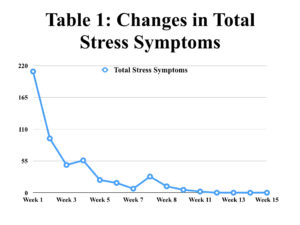
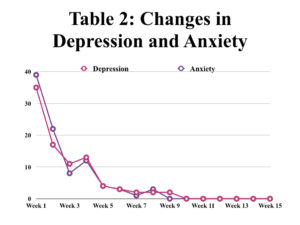
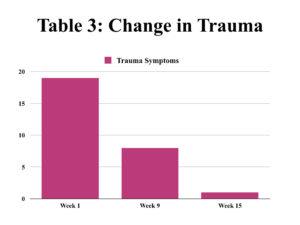

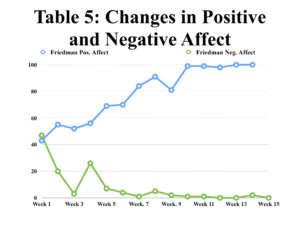
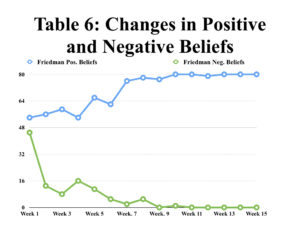
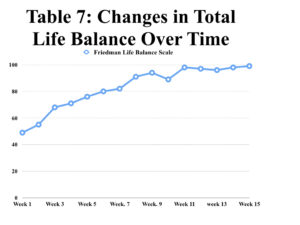
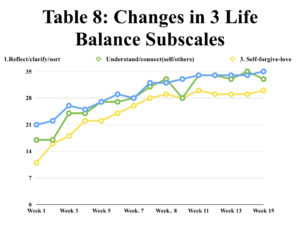
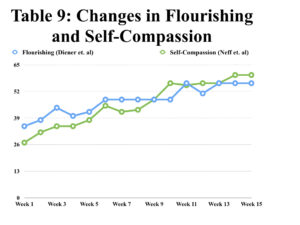
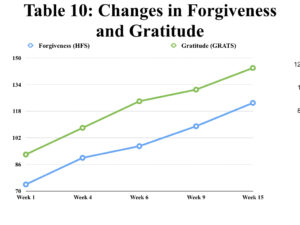
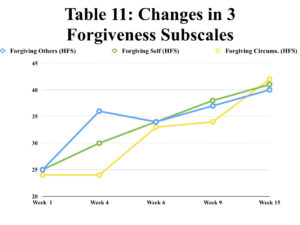
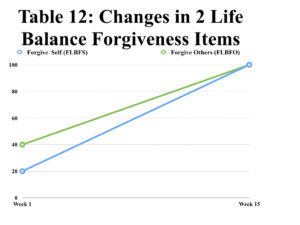
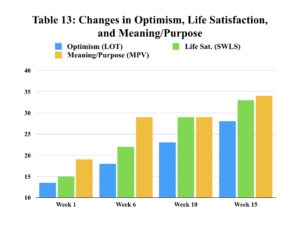
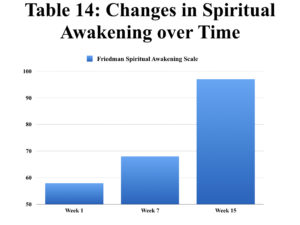
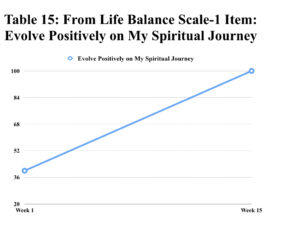
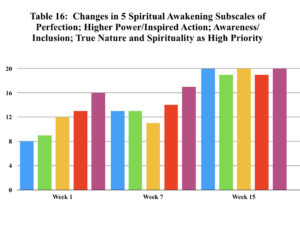
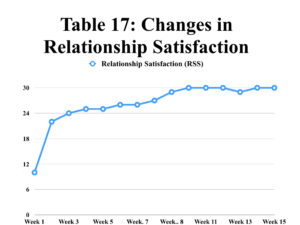
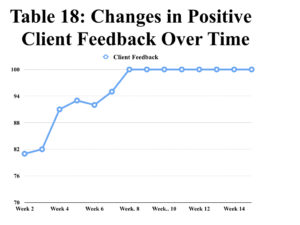
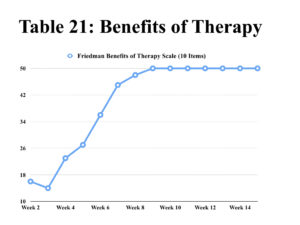




Dr. Friedman is one of those rare clinicians who uses his scientific training to empirically measure and track the progress of his patients and the effectiveness of his interventions. He is a model of the Boulder Scientist-Practitioner that hopefully the next generation of clinicians will learn from and emulate!
Thank you for your very kind words and pointing out the value of the Practice
Based Evidence Approach (PBEA) that I have been using explicitly since 1980 and probably since my graduate school days at the University of Wisconsin and my NIMH post-doc at Temple University Medical School under Arnold Lazarus, Ph.D and Joe Wolpe, M.D. However, it was at Columbia College as an undergrad that I first fell in love with tracking the development of change over time session by session. You are correct that it follows the Boulder Scientist-Practitioner model though that wasn’t my conscious thought when developing this approach. Your feedback is much appreciated.
Fascinating to see the integration of Spirituality in the healing process, I believe the awareness of the patient’s truth comes best when clearing through the chatter and allowing the patient to reveal their Spiritual voice
Yes Connecting with your Higher Self or Truth is essential. and then listening to your Inner Voice. Philip FriedmanI developed the Spiritual Awakening Scale to help assess the extent to which client’s move in the spiritual direction during therapy. Thanks for your comment. It is greatly appreciated.
Thank you Dr. Friedman for a great case study.
You are very welcome. Thanks for the positive feedback.
This is sooooooo exciting!! I’ve been using Energy Psychology with my clients for many, many years and it has been THE thing that has moved them forward in their self-understanding , healing, and moving into who they truly want to be – are! I’m sooooo excited that Psychology is FINALLY beginning to look at and acknowledge the gifts of this field! Keep moving forward….
Berti. It is great that you have been using energy psychology (EP) with your clients for many years and no doubt it has helped many people in their lives. EP approaches are very powerful and once learned relatively easy to use. I, and perhaps you, have been an early adopter of EP techniques. Also I and perhaps you have added new developments or variations to the EP field. Now more of our colleagues are introducing these innovative approaches into their work as well. Congratulations and thanks for sharing your experience.
An extremely comprehensive case study that really provides the follow up information we’d love to have with every patient/client we treat. Dr. Friedman did a wonderful job of connecting it all to the power of forgiveness, which is not always an easy concept to help people to consider.
Thanks Michael for your kind words. Yes the Practiced-Based Evidence Approach (PBEA) I use does allow for ongoing and follow-up information on clients by tracking change session by session. Of course, forgiveness is a powerful though sometimes challenging idea to understand and implement in everyone’s life. The many tools/techniques in my Forgiveness Solution book are designed to facilitate that. Even so it often takes skillful clinical work to help clients put it into practice.